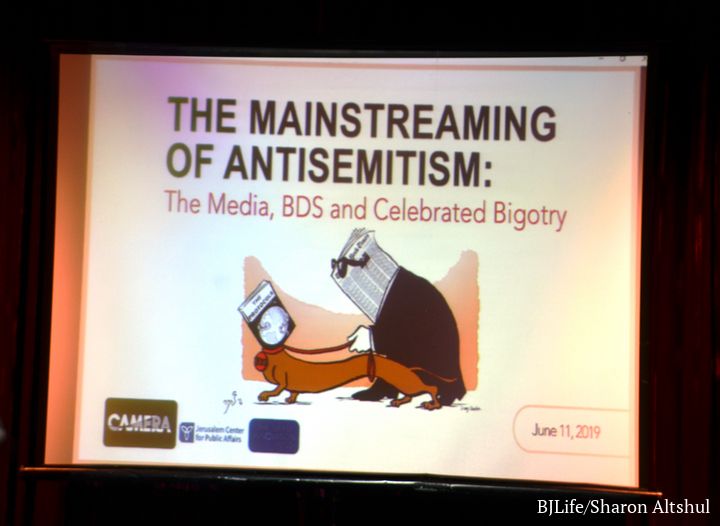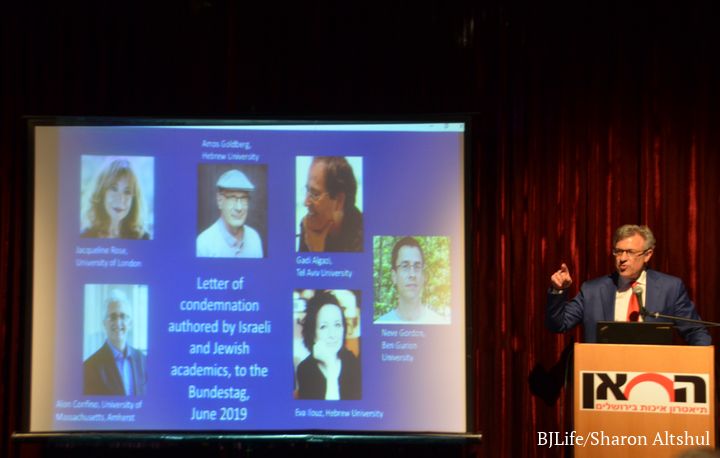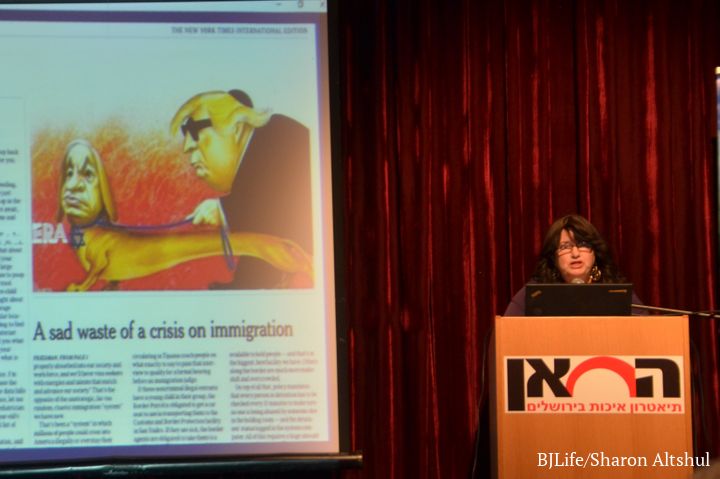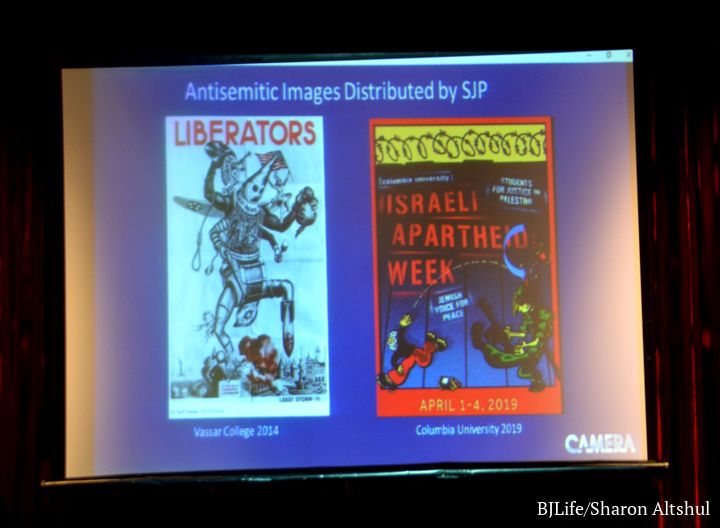Jerusalem, Israel, June 12, 2019 - At a June 11th event hosted by CAMERA at the Kahn Theatre in Jerusalem, Israel, a panel of experts examined how expressions of anti-Jewish bigotry have gained ground and acceptance in the media and on college campuses.
Co-sponsored by the Jerusalem Center for Public Affairs and The Israel Innovation Fund, IIF, the event’s title initially emphasized that antisemitism is often hidden under the veil of human rights.
“Why now?” asked David Hazony cofounder of IIF in his opening remarks, “Is it possible that antisemitism and assimilation are two sides of a coin?”
“The New York Times’ publication of a cartoon straight out of Nazi propaganda ripped away the veil,” said Tamar Sternthal, Director of CAMERA’s Israel office.
The New York Times cartoon, which was published in April, exposed the increasing prevalence of antisemitism in the mainstream media.
The cartoon depicted a blind, kippah-wearing President Donald Trump being led by Israeli Prime Minister Benjamin Netanyahu as his guide dog, tagged with a Magen David. The cartoon caused a social media uproar after the image was shown to mirror caricatures in Nazi publications of the 1930s and 40s.
“After the cartoon was published, it was clear that even in The New York Times explicit, blatant antisemitism can sneak its way into the mainstream news. This compelled us to focus our event on mainstreaming of antisemitism,” added Sternthal, it’s dressed up as mere criticism of Israeli policy.
Dan Diker, Director of the Project on Political Warfare and BDS at the Jerusalem Center for Public Affairs, acknowledged former MK Anat Berko, an expert in counterterrorism and her husband Reuven, an expert in Arab affairs, who along with historian Joel Fishman, were helpful in his career development, and in the audience.
Diker spoke of the German parliament’s recent resolution condemning BDS, Boycott, Divestment, and Sanctions of Israel, as antisemitic. Diker noted that the only two groups condemning the German parliament’s censure of BDS as antisemitic were Hamas and 240 Israeli and Jewish academics.
“It’s been said that you can put lipstick on a pig, but it’s still a pig. When it comes to BDS, when Jews put lipstick on a pig, it convinces the world that the pig is kosher,” Diker stated.
Ricki Hollander, CAMERA senior media analyst, said that journalists all too often use double standards or distort, conceal and revise the facts in order to maintain a narrative of Israeli guilt.
“They’re not relaying legitimate criticism of Israel. They are engaging in "Israelophobia" that masquerades as criticism of Israel."
Hollander said that there are other cultural factors that inform the media’s mainstreaming of antisemitism. “Many journalists are now rooted in an educational culture ruled by identity politics and partisan activism. And in the hierarchy of perceived victimhood within this culture, Jews are not even ranked. They're erroneously seen as white, privileged and powerful, on the other side of the divide.”
The antisemitic BDS campaign is also growing on American campuses.
“Over the years, Students for Justice in Palestine (SJP) chapters across the US have shared antisemitic literature, trying to hide it under the guise of anti-Zionism. But their mistakes have, at times, revealed their true colors,” said Aviva Rosenschein, International Campus Director for CAMERA.
While The New York Times’ April cartoon used Nazi-like imagery, Rosenschein gave examples of SJP chapters on American campuses that use actual Nazi imagery in materials that are supposed to be mere criticism of Israel.
According to Rosenschein, a collaboration between SJP and Jewish Voice for Peace (JVP), another radical anti-Israel organization, is also fueling antisemitism on campuses.
“Neither SJP nor JVP represents mainstream Jews and yet both groups somehow think that they are in a position to decide what constitutes discrimination and bigotry against Jews,” Rosenschein remarked.
Unfortunately, the antisemitic agenda of groups like SJP and JVP are often glossed over and misunderstood by university administrations.
“The more chancellors, administrators, university donors, faculty and students understand the real goals of these extremist organizations, the more allies we will have to stand up against their hate. We cannot expect the average American to know about these difficult issues; we must be willing to educate others,” Rosenschein concluded.
The audience was given an opportunity to pose questions to the panel at the conclusion of the prepared presentations.
About CAMERA
CAMERA is an international media-monitoring and educational organization founded in 1982 that works to promote more accurate, balanced and complete coverage of Israel and the Middle East. For more information visit: www.camera.org



















